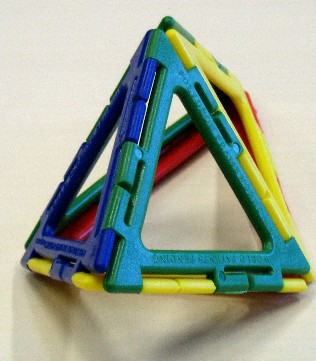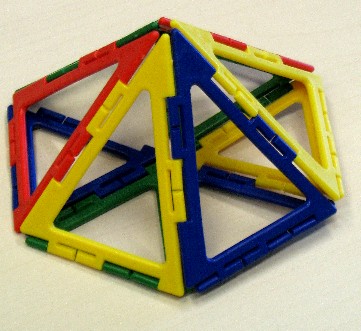



 Here ares some examples. The empty red triangles in the third example still count as faces.
Here ares some examples. The empty red triangles in the third example still count as faces.
For the moment, let us define polyhedra aas follows: A polyhedron is a three-dimensional object created by putting flat polygons together such that two polygons are joined by a common edge, and every edge bounds two polygons. Obviously every polyhedron could also be viewed as a graph, since we have vertices---the vertices of the polygons--- that are connected by edges. The degree of a vertex in the polygon is the number of edges it is incident with. It is the same as the degree in the graph-theoretical sense.
For some famous polyhedra, all faces have the same shape---they are regular n-gons for a fixed value of n. This is true for the five Platonic Solids, where all faces are regular polygons of only one shape, and every vertex has the same degree.
| Name (click for animation) | Tetrahedron | Cube | Octahedron | Dodecahedron | Icosahedron |
| Look |

|

|

|

|

|
| degree (number of faces or edges) at each vertex | 3 | 3 | 4 | 3 | 5 |
| V=number of vertices | 4 | 8 | 6 | 20 | 12 |
| E=number of edges | 6 | 12 | 12 | 30 | 30 |
| F=number of faces | 4 | 6 | 8 | 12 | 20 |
| degree (number of edges) of each face | 3 | 4 | 3 | 5 | 3 |
Since polyhedra are also graph, we know from the graph page:
Therefore the number of edges doesn't have to be counted but can be computed from the other parameters. In particular, since the graphs of Platonic solids are r-regular, (all vertices have the same degree r) we know that 2E=rV for them, i.e. E=rV/2. For instance, for the cube we have 3·8/2 edges, for the icosahedron we have 5·12/2 edges.
We want to be able to compute the number of edges also for non-Platonic polyhedra, i.e. for nonregular graphs. For this purpose we use the abbreviation of Vn for the number of vertices of degree n in every polyhedron, and in the same way Fn for the number of faces that are n-gons (bounded by n edges). Note that no vertex can have degree 2 in a polyhedron (Why not?)(although in a general graph it can) and of course, there are no 2-gons. Therefore Vn and Fn are always both equal to 0. Of course, since every vertex and every face have exactly one degree, V = V3+V4+V5+... and F = F3+F4+F5+... .
| Name | doghouse | double pyramid | Napoleon's hat | UFO | ||
| Look | 
|

|

|

|

|
 The base is considered to be one 6-gon, instead of six triangles. |
| V3,V4,V5.... | 6,3 | 2,3 | 2,2,2 | 2,5 | 0,6,0,2 | 6,0,0,1 |
| V=number of vertices | 9 | 5 | 6 | 7 | 8 | 7 |
| E=number of edges | 15 = (3·6+4·3)/2 = (3·5+4·0+5·3)/2 | 9 = (3·2+4·3)/2 = 3·6/2 | 12 = (3·2+4·2+5·2)/2 = 3·8/2 | 13 = (3·2+4·5)/2 = (3·6+4·2)/2 | 18 = (3·0+4·6+5·0+6·2)/2 = 3·12/2 | 12 = (3·6+4·0+5·0+6·1)/2 =(3·6+4·0+5·0+6·1)/2 |
| F=number of faces | 8 | 6 | 8 | 8 | 12 | 7 |
| F3,F4,F5,... | 5,0,3 | 6 (all triangles) | 8 (all triangles) | 6,2 | 12 (all triangles) | or: 6,0,0,1 |
| nonconvex | self-dual |
Now the sum of all degrees of all vertices equals 3·V3 +4·V4+5·V5+ .... . Therefore the above remark can be restated as:
Start with any polyhedron. The middle of each face will become a new vertex. Now connect those new vertices by straight lines---the new edges---provided the corresponding faces share an edge. We get another polyhedron, having as many edges as the old one, as many vertices as the old one had faces, and as many faces as the old one had vertices. The dual of the cube is the octahedron, and the dual of the dodecahedron is the icosahedron. The tetrahedron is its own dual. The dual of the dual is the old poyhedron.
Recall that the degree of a face is the number of edges bounding it. It equals the degree of the corresponding vertex in the dual.
Truncating a polyhedron means: All vertices are sliced off (with a sharp knife). The cuts form new faces, with new vertices and new edges. Here you can see the truncated dodecahedron, and here the truncated icosahedron---the soccer ball, also displayed above in the logo.
How do V, E, F of the original polyhedron relate to vertex number VT, edge number ET, and face number FT of the truncated polyhedron?
In the same way as above, let us investigate how the vertex number VG, edge number EG, and face number FG of the glued polyhedron relate to these parameters V1, E1, F1 of the first polyhedron and V2, E2, F2 of the second polyhedron. Assume both polyhedra are glued together along an n-gon.